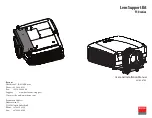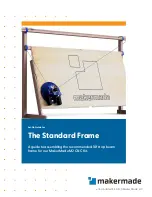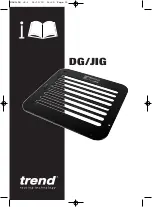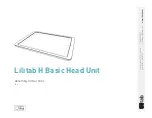
TROUBLE SHOOTING AND REPLACEMENT PARTS
TROUBLE SHOOTING / SERIAL PLATE
To order any replacement parts or when calling for assistance
with any powered conveyor,
ALWAYS
provide unit serial number.
Shown at actual size, this aluminum plate is placed on the
conveyor frame near the location of the drive assembly.
To order replacement parts or add-on components, contact
the Roach distributor who originally furnished the unit
if possible. If this is not possible, contact the National
Sales Office at 870-483-7631 for the name of the
authorized Roach distributor in your area. Have unit model
number and serial number
BEFORE
calling. Refer
to unit drawings (in rear section of handbook) for part numbers
if ordering replacement parts.
ORDERING REPLACEMENT PARTS
TROUBLE SHOOTING
TROUBLE
PROBABLE CAUSE
REMEDY
Motor & gear reduc-
er running excessively
hot, or hard to start
A. Drag on conveyor
B. Lack of lubricant
C. Frozen sprocket
D. Frozen roller
E. Overload
F. Electrical
A. Inspect entire conveyor for obstruction causing drag
on chain.
B. Check for leaks.
C. Check and inspect all sprockets and bearings. Replace
sprockets failing to rotate or that are difficult to rotate.
D. Check all rollers for rotation.
E. Reduce cause and/or increase motor horsepower.
F. Check wiring and circuits, take ampere reading, replace
motor if necessary.
Motor & gear re-
ducer makes exces-
sive noise
A. Lack of lubrication
B. Damaged Gears
C. Faulty Bearing
A. Check for leaks.
B. Replace unit.
C. Replace bearing.
Drive chain, con-
veying chain or
sprockets experience
excessive wear
A. Excessive chain tension
B. Sprockets misaligned
C. Chain not lubricated
D. Damaged sprocket or chain
E. Misalignment of chain guard
F. Dirty chain
A. Reduce chain tension.
B. Realign with straight edge across sprocket faces.
C. Lubricated chain with approved lubricant, wipe away
excess lubricant.
D. Replace Damaged Component.
E. Adjust chain guard assembly as necessary.
F. Clean thoroughly and lubricate with approved lubricant.
Drive chain,
conveying chain
or sprockets make
excessive noise
A. Insufficient chain tension
B. Chain not adequately
lubricated
C. Sprockets misaligned
A. Adjust chain tension.
B. Lubricate chain with approved lubricant, wipe away excess
lubricant.
C. Realign sprockets with straight edge across sprocket faces.
Pulsating chain
A. Insufficient chain tension
B. Misalignment of chain guard
C. Overload
A. Adjust chain tension.
B. Adjust chain guard assembly as necessary.
C. Inspect for obstruction to or drag on conveyor.
Broken chain
A. Frozen bearing or sprocket
shaft
B. Worn or damaged chain
C. Obstructed or jam
A. Inspect for damaged bearings, replace if necessary. Re
place links as required.
B. Replace chain as required.
C. Remove obstruction to clear jam.
Sprocket loose on
shaft
A. Loose set screws
B. Worn or damaged key
A. Realign sprockets with straight edge and tighten set screws.
B. Replace with new key.
Excessive slack in
chain
A. Normal wear
A. Expect rapid chain growth in first two weeks of operation.
B. Adjust chain tension as specified in the manual.
15
Содержание 138LRC
Страница 1: ......
Страница 9: ...V BELT PATHS V BELT PATH FOR SPURS AND CURVES 9...
Страница 17: ...MODEL 138LRC ILLUSTRATIONS FOR UNIT WITH END DRIVE SIDE MOUNT END DRIVE 17...
Страница 19: ...MODEL 196LRC ILLUSTRATIONS FOR UNIT WITH END DRIVE SIDE MOUNT END DRIVE 19...
Страница 21: ...MODEL 138LRCS ILLUSTRATIONS FOR UNIT WITH END DRIVE SIDE MOUNT END DRIVE 21...
Страница 23: ...MODEL 196LRCS ILLUSTRATIONS FOR UNIT WITH END DRIVE SIDE MOUNT END DRIVE 23...










































